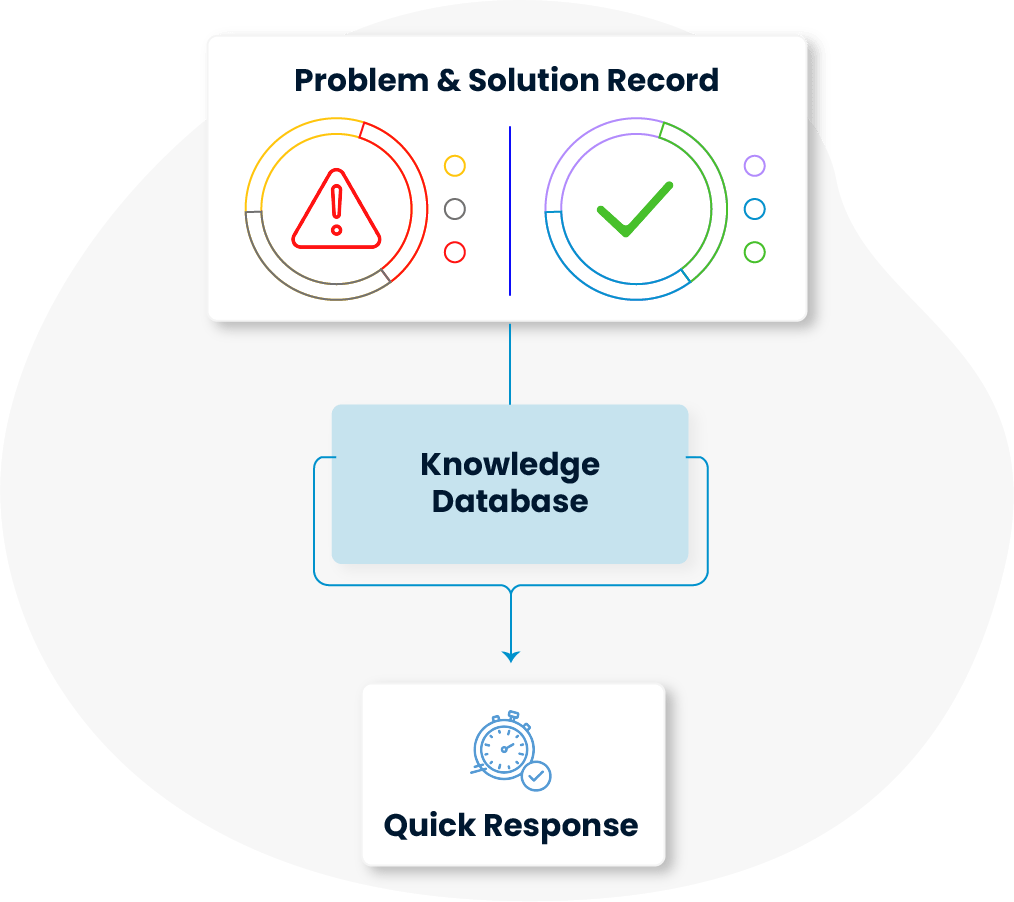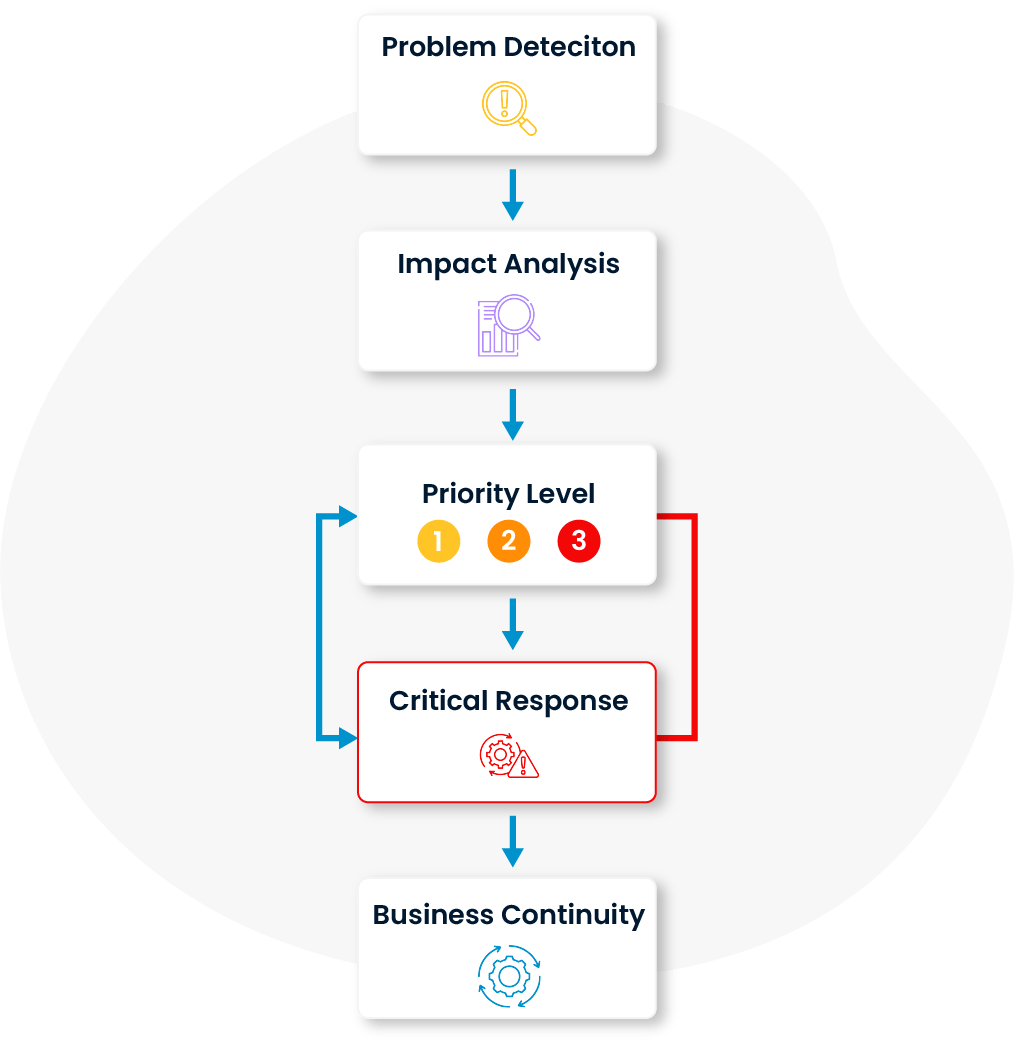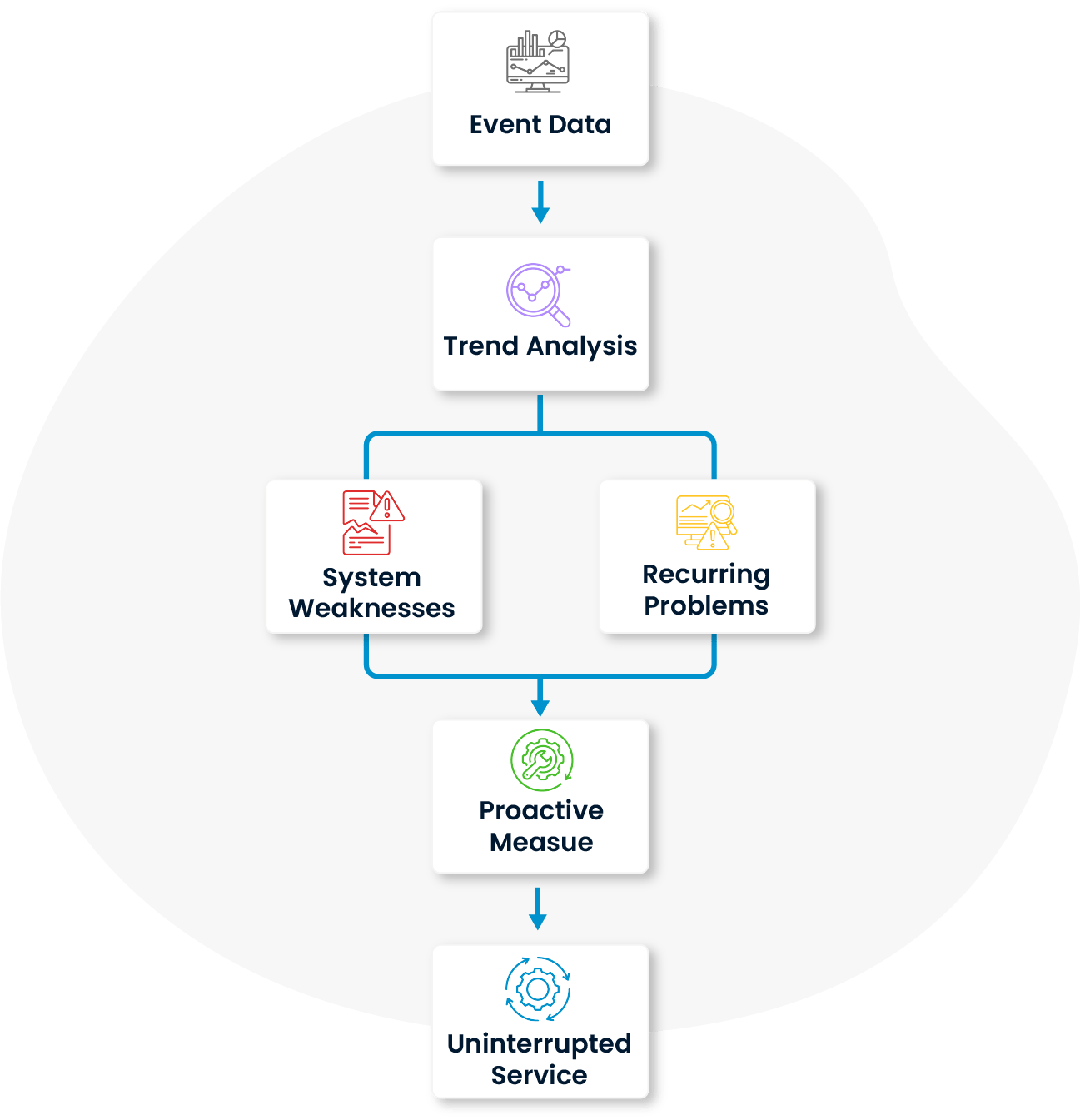Problem Management
Analyze recurring incidents in your IT infrastructure and minimize service disruptions by implementing permanent solutions. Identify root causes with problem management and eliminate system errors through effective error control processes.
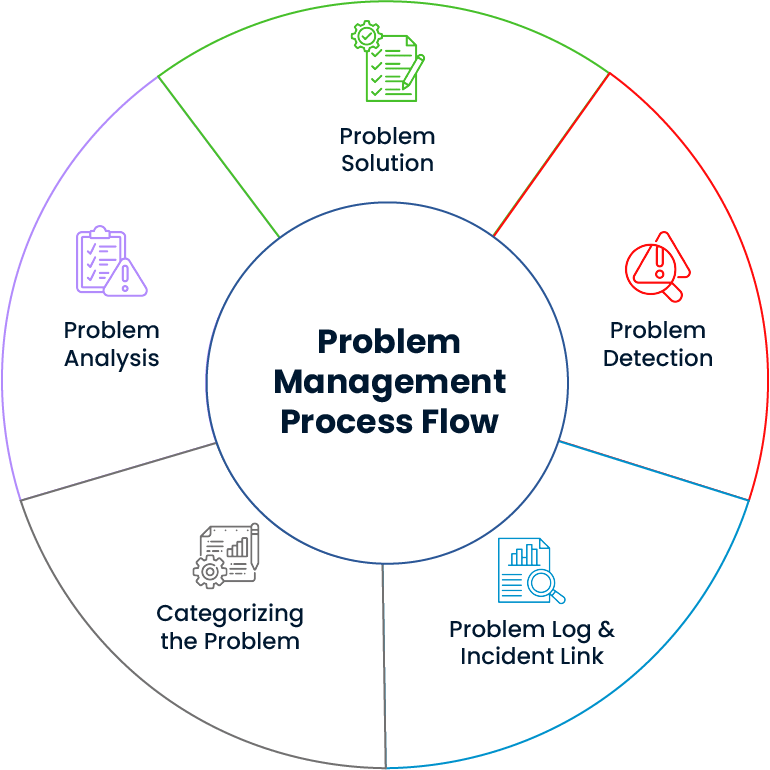
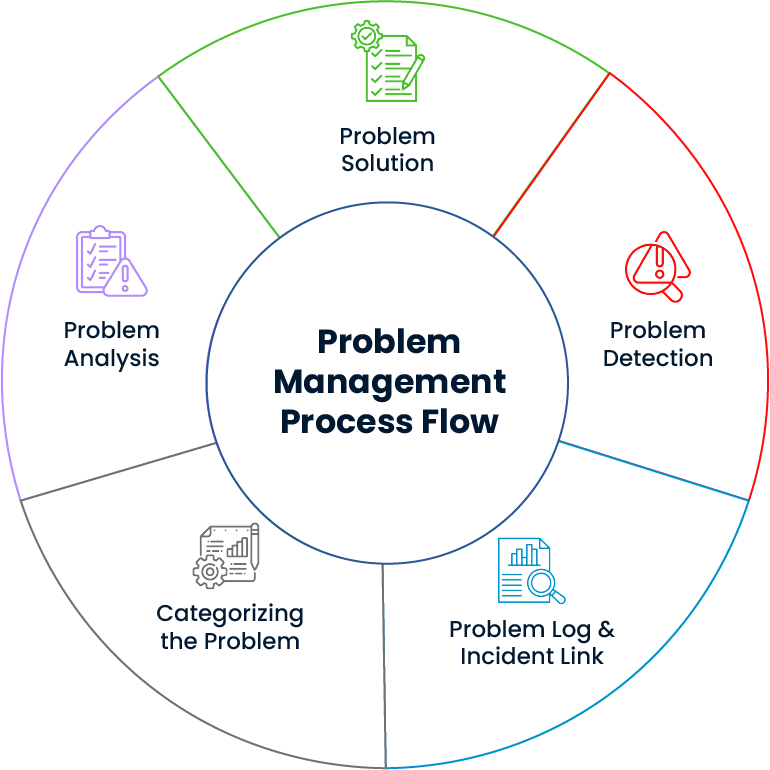
Analyze recurring incidents in your IT infrastructure and minimize service disruptions by implementing permanent solutions. Identify root causes with problem management and eliminate system errors through effective error control processes.
Benefits of the Problem Management

Problem management helps you go beyond treating symptoms and address the root causes of incidents, enabling permanent solutions. By doing so, recurring issues are systematically prevented, leading to sustainable improvements in your IT infrastructure.

With proactive problem management, issues are identified and addressed before they occur. This minimizes service interruptions and ensures the continuity of IT operations.

Every resolution is documented as part of problem management and stored in a comprehensive problem database. This knowledge base enables faster resolution of similar issues, reduces team workload, and helps lower operational costs.

Problem management reduces the likelihood of recurring incidents. As a result, incident management processes become faster, resources are used more efficiently, and IT teams can focus on more strategic tasks.

By minimizing the impact of issues, service disruptions are reduced. Users gain access to a more reliable and highquality IT infrastructure, leading to increased overall satisfaction.
Problem management helps you go beyond treating symptoms and address the root causes of incidents, enabling permanent solutions. By doing so, recurring issues are systematically prevented, leading to sustainable improvements in your IT infrastructure.
With proactive problem management, issues are identified and addressed before they occur. This minimizes service interruptions and ensures the continuity of IT operations.
Every resolution is documented as part of problem management and stored in a comprehensive problem database. This knowledge base enables faster resolution of similar issues, reduces team workload, and helps lower operational costs.
Problem management reduces the likelihood of recurring incidents. As a result, incident management processes become faster, resources are used more efficiently, and IT teams can focus on more strategic tasks.
By minimizing the impact of issues, service disruptions are reduced. Users gain access to a more reliable and highquality IT infrastructure, leading to increased overall satisfaction.
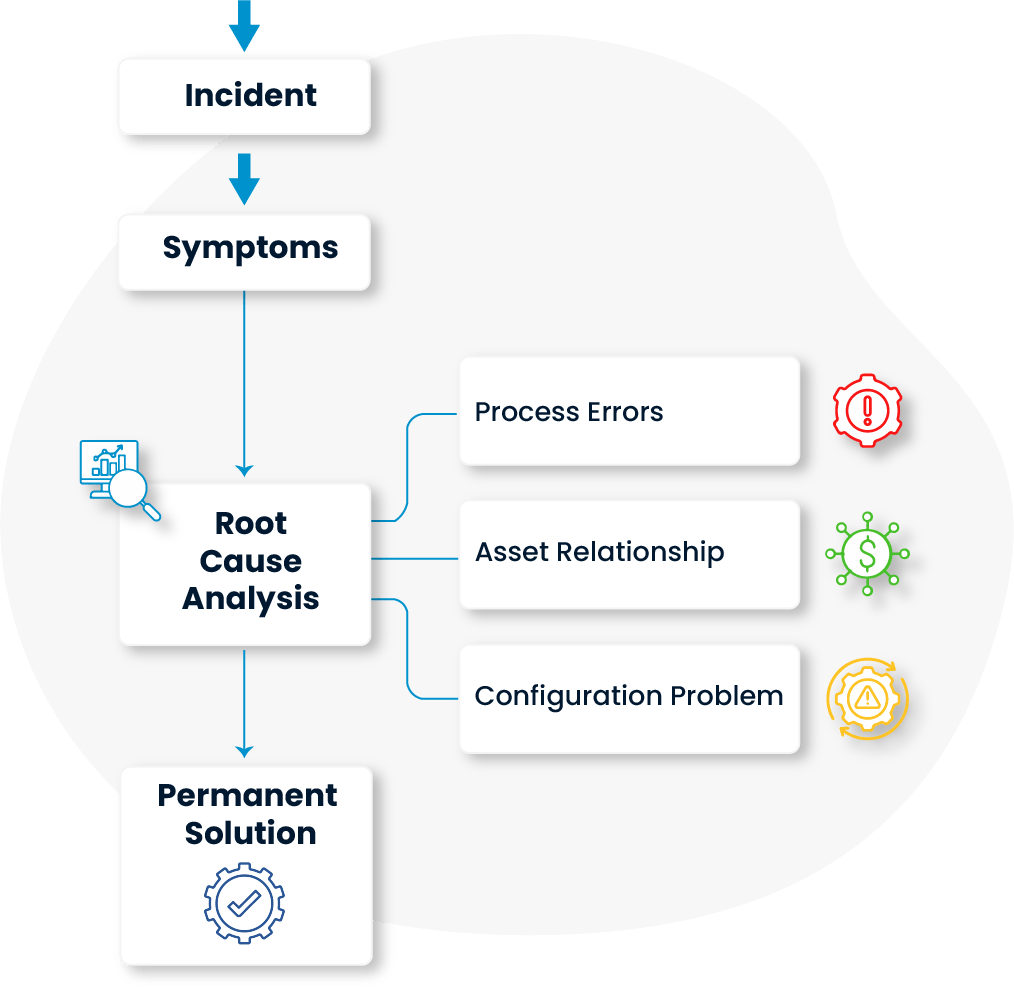
Warning: Undefined array key "background_image" in /home/spidyac/public_html/wp-content/plugins/elementor/includes/conditions.php on line 87
Warning: Trying to access array offset on value of type null in /home/spidyac/public_html/wp-content/plugins/elementor/includes/conditions.php on line 90
Warning: Undefined array key "background_image" in /home/spidyac/public_html/wp-content/plugins/elementor/includes/conditions.php on line 87
Warning: Trying to access array offset on value of type null in /home/spidyac/public_html/wp-content/plugins/elementor/includes/conditions.php on line 90
The true underlying causes of incidents are uncovered through detailed analysis. In this process, not only the symptoms are addressed via incident management, but also the contributing processes and factors related to asset and configuration management are improved. This creates a solid foundation for delivering permanent solutions.
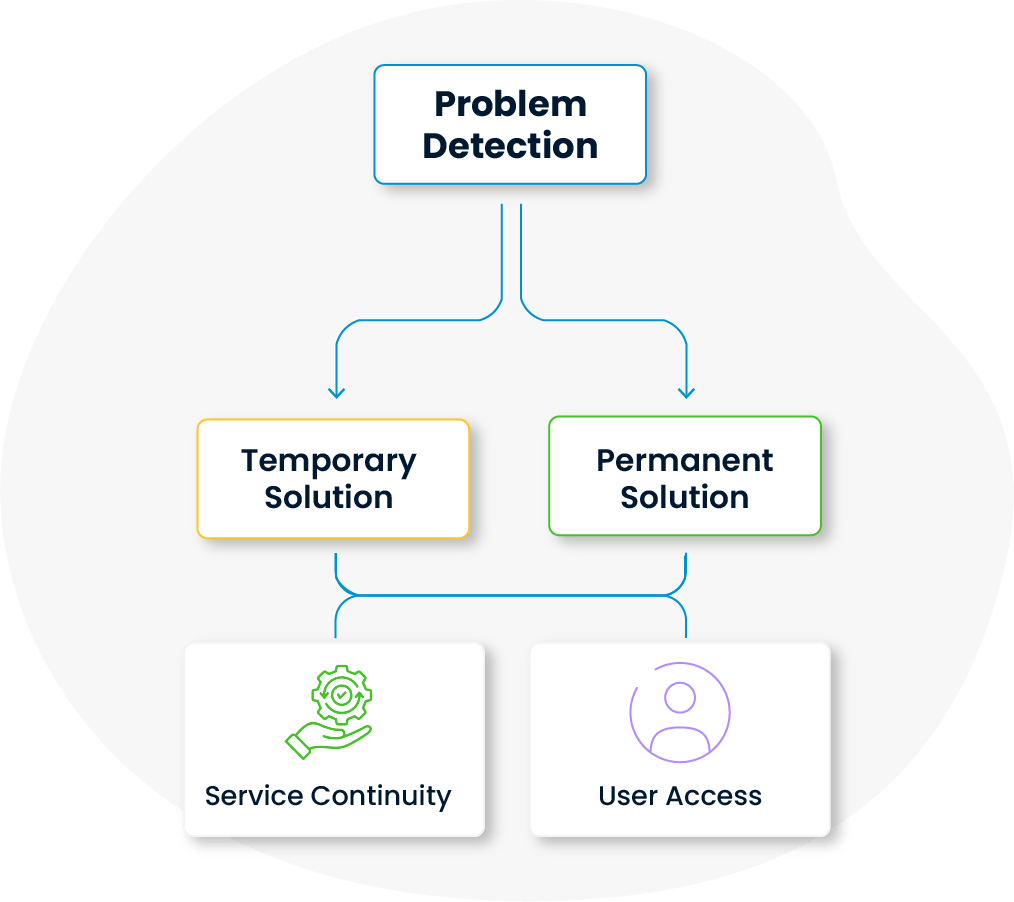
Warning: Undefined array key "background_image" in /home/spidyac/public_html/wp-content/plugins/elementor/includes/conditions.php on line 87
Warning: Trying to access array offset on value of type null in /home/spidyac/public_html/wp-content/plugins/elementor/includes/conditions.php on line 90
Warning: Undefined array key "background_image" in /home/spidyac/public_html/wp-content/plugins/elementor/includes/conditions.php on line 87
Warning: Trying to access array offset on value of type null in /home/spidyac/public_html/wp-content/plugins/elementor/includes/conditions.php on line 90
Warning: Undefined array key "background_image" in /home/spidyac/public_html/wp-content/plugins/elementor/includes/conditions.php on line 87
Warning: Trying to access array offset on value of type null in /home/spidyac/public_html/wp-content/plugins/elementor/includes/conditions.php on line 90
Warning: Undefined array key "background_image" in /home/spidyac/public_html/wp-content/plugins/elementor/includes/conditions.php on line 87
Warning: Trying to access array offset on value of type null in /home/spidyac/public_html/wp-content/plugins/elementor/includes/conditions.php on line 90
Until a permanent resolution is found, temporary measures are implemented in line with problem management principles to ensure service continuity.
These interim steps allow users to continue their business processes without disruption and help protect against operational setbacks.
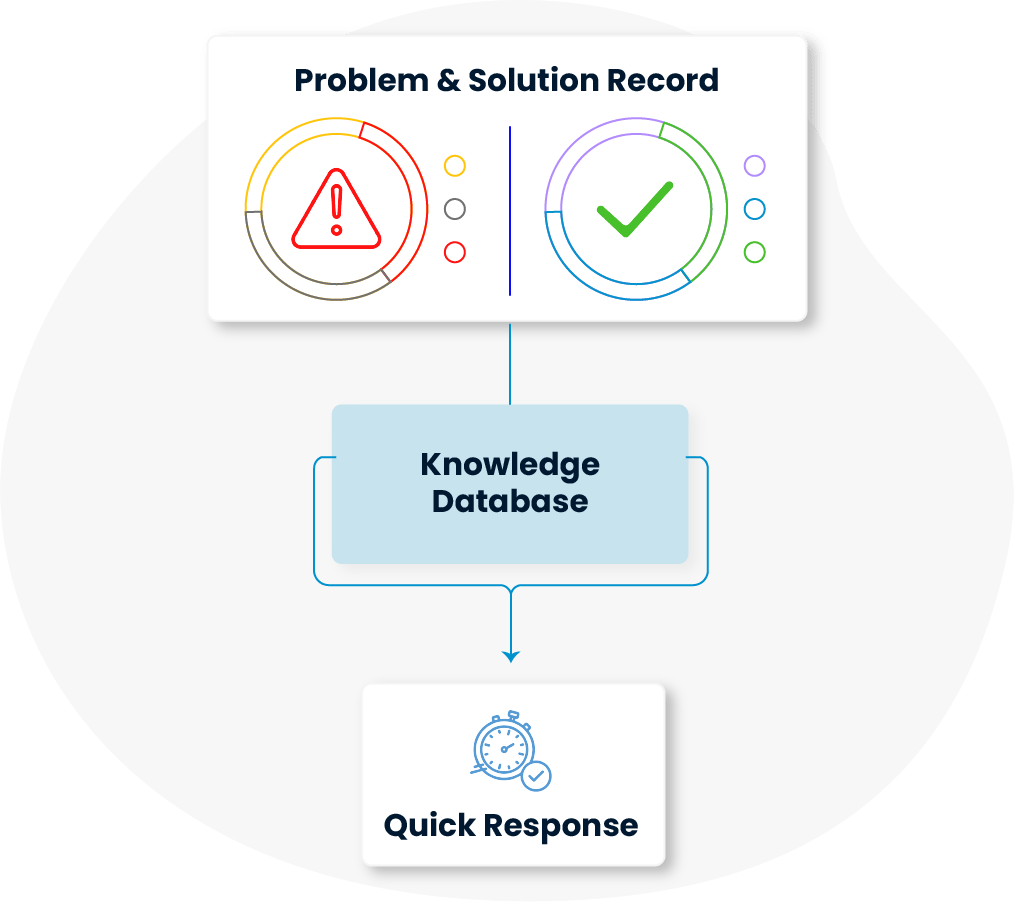
Warning: Undefined array key "background_image" in /home/spidyac/public_html/wp-content/plugins/elementor/includes/conditions.php on line 87
Warning: Trying to access array offset on value of type null in /home/spidyac/public_html/wp-content/plugins/elementor/includes/conditions.php on line 90
Warning: Undefined array key "background_image" in /home/spidyac/public_html/wp-content/plugins/elementor/includes/conditions.php on line 87
Warning: Trying to access array offset on value of type null in /home/spidyac/public_html/wp-content/plugins/elementor/includes/conditions.php on line 90
Past problems and their resolutions are systematically recorded and organized within the system. This structure creates a knowledge base as part of problem management, enabling teams to respond quickly and effectively when similar issues arise.
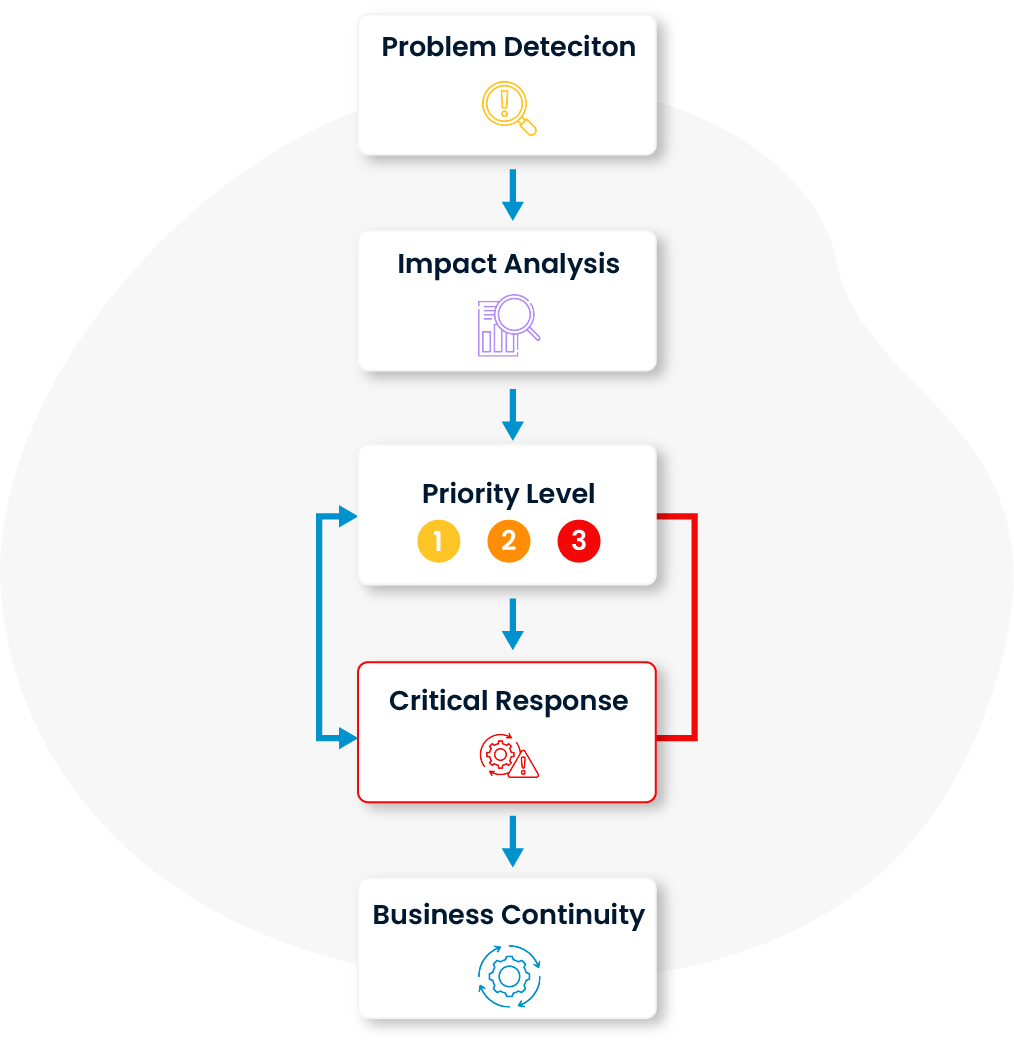
Warning: Undefined array key "background_image" in /home/spidyac/public_html/wp-content/plugins/elementor/includes/conditions.php on line 87
Warning: Trying to access array offset on value of type null in /home/spidyac/public_html/wp-content/plugins/elementor/includes/conditions.php on line 90
Warning: Undefined array key "background_image" in /home/spidyac/public_html/wp-content/plugins/elementor/includes/conditions.php on line 87
Warning: Trying to access array offset on value of type null in /home/spidyac/public_html/wp-content/plugins/elementor/includes/conditions.php on line 90
The impact of problems on IT services is thoroughly analyzed and prioritized accordingly. This ensures that issues affecting the most critical systems are addressed first, incident management processes are handled efficiently, and business continuity is maintained.
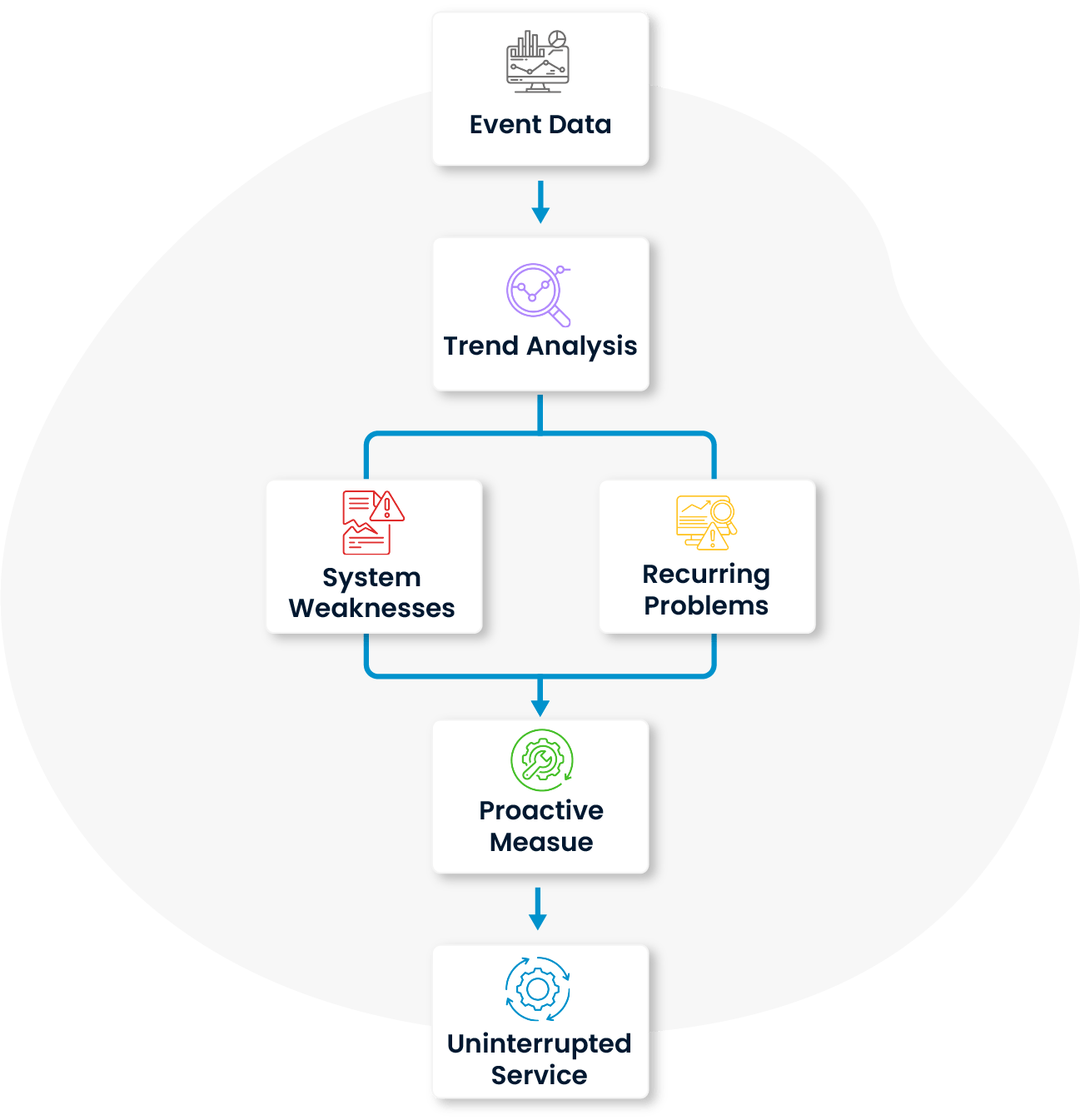
Warning: Undefined array key "background_image" in /home/spidyac/public_html/wp-content/plugins/elementor/includes/conditions.php on line 87
Warning: Trying to access array offset on value of type null in /home/spidyac/public_html/wp-content/plugins/elementor/includes/conditions.php on line 90
Warning: Undefined array key "background_image" in /home/spidyac/public_html/wp-content/plugins/elementor/includes/conditions.php on line 87
Warning: Trying to access array offset on value of type null in /home/spidyac/public_html/wp-content/plugins/elementor/includes/conditions.php on line 90
The likelihood of incident recurrence is analyzed to identify similar patterns and system vulnerabilities in advance. This enables error control mechanisms to activate and strategic steps to be taken for uninterrupted service delivery in the IT infrastructure.

Problem management helps you go beyond treating symptoms and address the root causes of incidents, enabling permanent solutions. By doing so, recurring issues are systematically prevented, leading to sustainable improvements in your IT infrastructure.

With proactive problem management, issues are identified and addressed before they occur. This minimizes service interruptions and ensures the continuity of IT operations.

Every resolution is documented as part of problem management and stored in a comprehensive problem database. This knowledge base enables faster resolution of similar issues, reduces team workload, and helps lower operational costs.

Problem management reduces the likelihood of recurring incidents. As a result, incident management processes become faster, resources are used more efficiently, and IT teams can focus on more strategic tasks.

By minimizing the impact of issues, service disruptions are reduced. Users gain access to a more reliable and highquality IT infrastructure, leading to increased overall satisfaction.
Features of the Problem Management Module
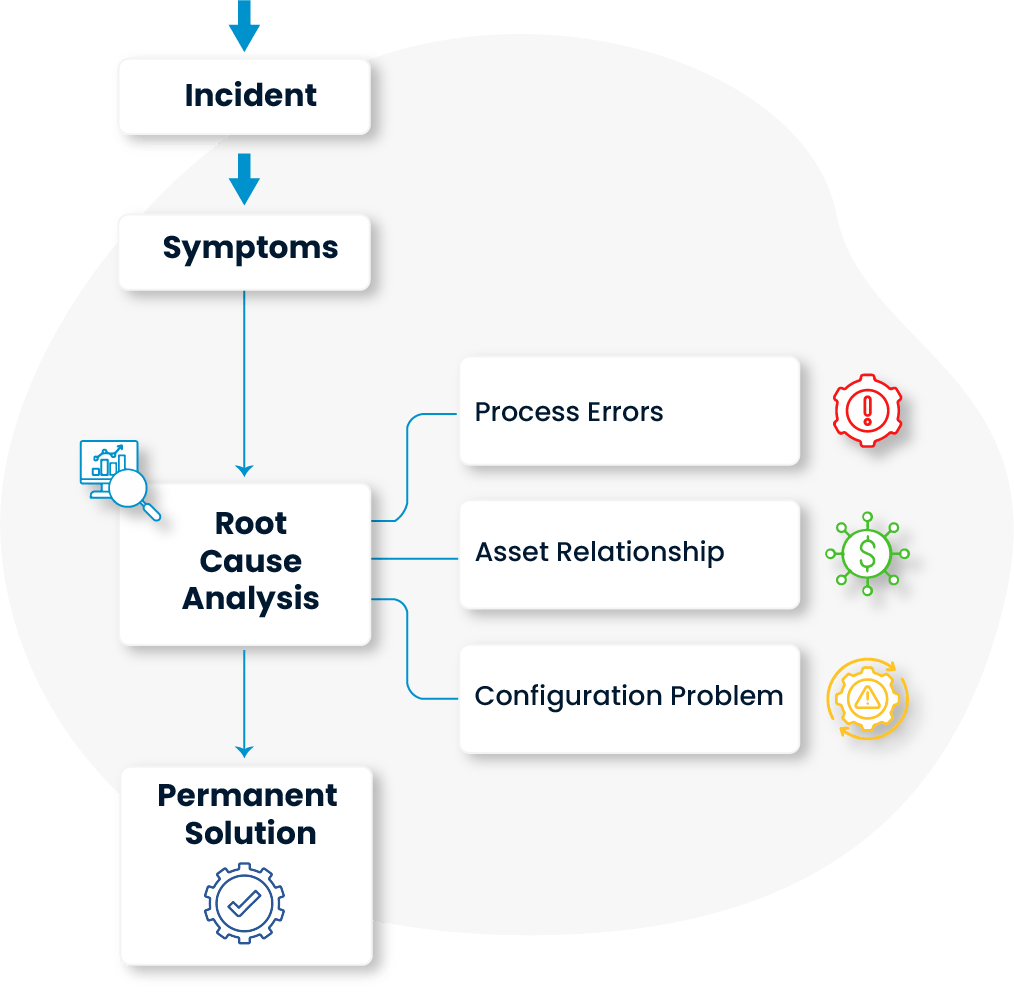
Root Cause Analysis

Frequently Asked Questions (FAQ)
Incident management aims to restore service as quickly as possible, while problem management focuses on identifying and eliminating the root causes of incidents. Even if an incident is temporarily resolved, the problem management process continues to ensure permanent resolution of root causes.
The module targets permanent solutions to recurring incidents. By applying lasting fixes, the risk of recurrence is significantly reduced, supporting continuous improvement.
The problem database is intended for IT teams to document and manage issues. Although not directly accessible to end users, it facilitates faster action on similar future problems and serves as a reference during ticket handling.
Workarounds keep services running but are always supported by permanent solutions in the long term. All temporary measures are recorded and monitored within the system through error control mechanisms.
Detailed reports are available on resolution times, problem frequency, downtime duration, SLA compliance, and user feedback to help track performance metrics.
If You Have Any Other Questions, Contact Us!
Incident management aims to restore service as quickly as possible, while problem management focuses on identifying and eliminating the root causes of incidents. Even if an incident is temporarily resolved, the problem management process continues to ensure permanent resolution of root causes.
Problem management targets permanent solutions to recurring incidents. By applying lasting fixes, the risk of recurrence is significantly reduced, supporting continuous improvement.
The problem database is intended for IT teams to document and manage issues. Although not directly accessible to end users, it facilitates faster action on similar future problems and serves as a reference during ticket handling.
Workarounds keep services running but are always supported by permanent solutions in the long term. All temporary measures are recorded and monitored within the system through error control mechanisms.
Detailed reports are available on resolution times, problem frequency, downtime duration, SLA compliance, and user feedback to help track performance metrics.

